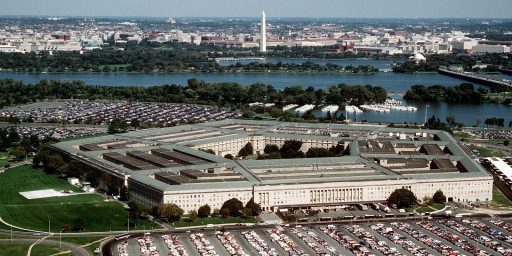FLAWED CASE FOR WAR?
The lede in today’s WaPo print edition is Glenn Kessler and Walter Pincus’ piece, “A Flawed Argument In the Case for War.”
The information was so startling that CIA Director George J. Tenet, accompanied by Vice President Cheney, marched up to Capitol Hill to brief the four top Senate and House leaders the day after Labor Day 2002. The administration was gearing up to present its case against Iraq at the United Nations, and lawmakers were eager for any evidence that would prove Saddam Hussein was a grave threat.
In the briefing, Tenet and Cheney presented what one participant described as a “smoking gun” : New intelligence showed Iraq had developed unmanned airborne vehicles (UAVs) that could deliver chemical or biological agents. In addition, Iraq had sought software that would allow it to produce sophisticated mapping of eastern U.S. cities. President Bush hinted at the evidence in a speech on Oct. 7, 2002.
And a year ago, when Secretary of State Colin L. Powell made a lengthy presentation before the U.N. Security Council, he echoed the concern: “Iraq could use these small UAVs, which have a wingspan of only a few meters, to deliver biological agents to its neighbors or, if transported, to other countries, including the United States.”
Since Powell’s speech, however, investigations by U.S. weapons inspectors have determined that the UAVs, or drones, were not designed to spread deadly toxins but to fly unarmed reconnaissance missions.
The story of the UAVs — just one part of the vast array of claims made by the Bush administration about Iraq’s alleged weapons programs — is emblematic of how U.S. intelligence on Iraq was often wrong, even when officials made efforts to cull the strongest material from a torrent of information.
In preparing for his U.N. speech on Feb. 5, Powell had prided himself on spending long hours at the CIA, quizzing analysts who had developed the material and making certain the information had not just one source but was developed from a combination of human, signal and satellite intelligence. He even refused to include a reference to the mapping software that had spurred the congressional meeting, believing that it was not credible.
But in the end, much of that effort appeared to be for naught. David Kay, the chief U.S. inspector who recently resigned, has spent the past week telling reporters and Congress that there appear to be no weapons of mass destruction in Iraq. Only fragments of Powell’s presentation have been confirmed despite months of searching.
“It looks terrible,” said Joseph Cirincione, director of the nonproliferation project at the Carnegie Endowment for International Peace. “None of his core assertions about Saddam’s growing arsenal of weapons of mass destruction turned out to be true.”
The print edition has a giant chart which essentially Fisks the Powell speech, presenting snippets against “what we now know.”
The problem with all this is that it’s done with the advantage of hindsight. We had every reason to believe that Saddam had chemical and biological weapons, harbored ambitions of acquiring nuclear weapons, and had made significant progress towards developing them two times before. We knew he had UAVs and other conventional weapon systems that could easily be armed with NBC weapons. Saddam had a treaty obligation to destroy all of his NBC stockpiles and provide documentary evidence that he had in fact done so. He failed to live up to that obligation. So, presuming that it turns out that the weapons we knew he had as late as 1998 were in fact secretly destroyed–which, frankly, defies all logic even though it increasingly looks to be the case–how is it that Powell and Co. were supposed to know this?





I dunno, if Occam were here he would say we just have not found the weapons yet. However implausible that may be.
But the CIA was not alone. Was the whole world wrong?
Seems to me the whole world could say it believes something — the sky is blue, the sun sets in the east, etc. — but as soon as the CIA says it believes the same thing, the whole world has a tendency to do a 180 and not only disagree with the CIA, but deny ever having said previously what the CIA is saying now.
the sun sets in the east
West. The sun sets in the west.
Where’s my coffee, dammit?
I dunno, if Occam were here he would say we just have not found the weapons yet.
Um, no. Occam’s Razor says that the simplest theory is most probably true. The simplest explanation is that our intelligence was wrong and there were no WMD in the first place. To believe that we just haven’t found them yet, you have to believe that (1) they were hidden, (2) we didn’t notice them being hidden, and (3) no one in Iraq noticed they were being hidden, either (or at least, anyone who noticed is unwilling to tell.) Since the former requires fewer steps, it’s the more likely explanation.
ummm Hello??? Are you awake?
To believe they never existed is to believe dozens of intelligence agencies in different countries acting independently all found evidence of something that never existed.
THEN, since we know they existed at one point, you need to believe he destroyed the weapons BUT he never provided proof to the international community.
Further, you have to believe that although Saddam worked tirelessly to have the U. N. sanctions removed, he suffered thru a dozen years of those sanctions when all he had to do to have them lifted was admit he destroyed his weapons.
Of course, you also need to believe that he practiced hiding them for a dozen years but then would not actually be able to do it when the time came.
AND finally (only because I’m bored, I’ve got plenty more) you need to believe he would take his country to a war he surly would lose and give up his power over something he never had.
OH SURE, your thing is much more plausible. NOT!
The American military could have figured out handily how to use the UAVs for distributing biological agents, and the American military could have easily figured out how to transport the UAVs to another country to use them against that country.
The threat of the UAVs was not what Iraq was capable of doing with them, but what the smartest person possible could have done wtih them. In other words, to say that the UAVs were not a threat, one would have to assume that the Iraqis were too stupid to figure out how to use them . . . and I don’t think I want my country’s defense to be based on the assumption that we don’t need to bother because the enemy is too stupid to figure out how to attack us.
Well, this could be a “Kremlin” problem.
Back in the 70s, the aparatchniks in the USSR told their higher-ups that production was booming, quotas were being met, everything was moving along. The CIA found these reports and believed them. After all, that’s what they are telling their own Politburo. They wouldn’t lie to THEM, would they?
IF you had the same case here, that would explain why Saddam acted as he did, why several independent intelligence agencies would have the same viewpoint. Once again, would anyone lie to Saddam, knowing what would happen if he were caught?
The problem with these reports is that they all assume the Bush administration went to war on the basis of specific, concrete evidence that Saddam was an imminent threat to the United States and allies.
The fact that the US military camped on Saddam’s doorstep for months prior to the war indicates that the danger from Hussein’s WMD was neither imminent nor immense.
But we can all agree that the President, the US Congress, American and Western intelligence agencies, the UN, even Saddam’s own Arab neighbors knew in their gut that Saddam–and his sons–were a long-term threat. The Kay report agrees with this consensus. Clinton, in 1998, signed the Iraq Liberation Act, arguing that regime change in Baghdad was the only feasible solution to the Saddam problem
The Bush team knew that they could no longer rely on the UN embargo to continue keeping Saddam in his box–the UN’s own Permanent Security Members were arming and trading with Saddam’s regime.
http://www.khanreport.com/content/031203.html
Sanctions, which had killed nearly a million Iraqis, alienating vast swathes of the Muslim world, had become a recruiting bonanza for terrorist organizations such as Al Qaeda. Bin Laden exploited the suffering of the Iraqi people to onboard jihadists against America.
The terrorist attacks on American soil on September 11, 2001 produced the need for a proactive rather than a reactive national security decision-making paradigm.
The State Department, reduced over the years to compiling and editing a list of Middle Eastern rogue regimes, terrorist entities, and their allies agreed that America needed a preemptive doctrine to combat rogue regimes that pursued WMD.
With the launch of the War on Terror, Bush signaled that we will no longer wait to be hit before we respond.
Last year, the Bush administration tied (rightly) Islamic terrorism to the lack of democratic freedoms in the Arab and Muslim world.
To ebb the production of brainwashed, repressed, angry, young Muslims committed to the destruction of America, Israel, and the West, America must commit itself to transforming the Middle East, Bush argued. This “forward strategy” is the project for the new American century.
Iraq is an important step in that process. We have shown that we can no longer turn a blind eye to the actions of Arab dictators–Muslim scholars and terrorist masterminds can no longer claim that the United States is not interested in democracy in the Arab world.
Iraqis have seen for themselves that their greatest enemy is not the United States, as Saddam claimed, but the individuals who continue to slaughter innocent civilians–as the terrorists who struck the Kurdish HQs did earlier today–to further their own agenda.
Countries like Syria, Libya, Iran, Saudi Arabia and Pakistan–these last two the biggest challenges to the American project–have been sent a strong, unequivocal message: that America expects rapid fundamental reforms that puts an end to the production of the most deadly, undeterrable weapons of mass destruction–angry, brainwashed, martyrs dedicated to the cult of Islamic terrorism.
“…how is it that Powell and Co. were supposed to know this?”
Well, they might have paid some attention to the only people who were actually on the ground in Iraq – the UN inspectors. Remember those guys Hans Blix and Mohamed elBaradei?
“I dunno, if Occam were here he would say we just have not found the weapons yet. However implausible that may be.”
That gets more and more implausible each day (and it’s really really implausible by now). The key point for me aren’t the materials themselves, but the people: all the workers, soldiers, and grunts necessary to make WMD programs work. Where are all the squealers?
Where are all the squealers?
Shredded?
—